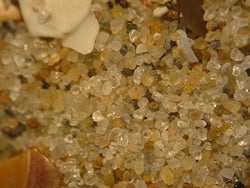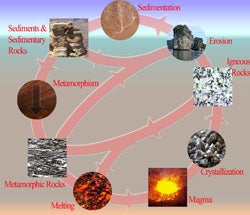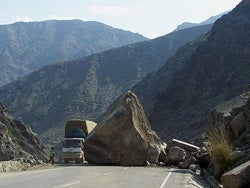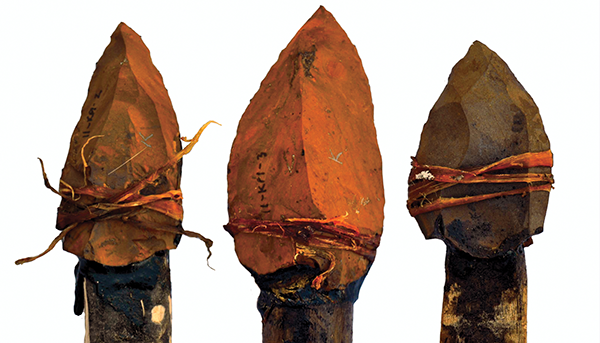
Where fossils lie: It’s not in a bed
 Rivers contain all sizes of rocks. Along the river side where ankle-deep water is almost at a standstill, sand and smaller grains collect to make a beach. Looking downstream the water is less deep so that rocks the size of your feet are peeking out of the water. Farther downstream, boulders the size of a school desk or larger may help cause the water to be very fast and choppy.
Rivers contain all sizes of rocks. Along the river side where ankle-deep water is almost at a standstill, sand and smaller grains collect to make a beach. Looking downstream the water is less deep so that rocks the size of your feet are peeking out of the water. Farther downstream, boulders the size of a school desk or larger may help cause the water to be very fast and choppy.
These various sized rocks are sediment, the most common type of rock we see. Sediments are what fossils are most commonly found in. Four types of sediments - clay, silt, sand, and gravel - are moved and deposited by wind and water. Sediment can also be deposited by a lake drying up and leaving salts. Or sediment can be made from many layers of shells or tiny organisms that lived in water and fell to the lake floor.
 Clay, silt, sand, and gravels are made from the breakdown of rocks. Three basic rock types are igneous, metamorphic, and sedimentary. Igneous rocks are the crystal solids of cooled magma or lava. Sedimentary rocks are formed by cemented sediments. Metamorphic rocks are rocks that have been altered deep below the surface by high temperatures and pressures. Each of these rock types will breakdown and become a part of the sediment.
Clay, silt, sand, and gravels are made from the breakdown of rocks. Three basic rock types are igneous, metamorphic, and sedimentary. Igneous rocks are the crystal solids of cooled magma or lava. Sedimentary rocks are formed by cemented sediments. Metamorphic rocks are rocks that have been altered deep below the surface by high temperatures and pressures. Each of these rock types will breakdown and become a part of the sediment.
 Car-sized boulders falling from mountainsides will break down over time to become the hand-sized cobbles and, sooner or later, sand. As it breaks down even more it will become microscopic silt and clay grains. Wind, water, freezing and thawing, and transport are what mostly break down these large rocks to small grains. Bones and other objects can be carried with the sediments and be deposited along with them. This loose sediment can then be hardened into sedimentary rocks, like sand will become sandstone. If fossils are found trapped in sedimentary rocks they have to be carefully removed from the rock.
Car-sized boulders falling from mountainsides will break down over time to become the hand-sized cobbles and, sooner or later, sand. As it breaks down even more it will become microscopic silt and clay grains. Wind, water, freezing and thawing, and transport are what mostly break down these large rocks to small grains. Bones and other objects can be carried with the sediments and be deposited along with them. This loose sediment can then be hardened into sedimentary rocks, like sand will become sandstone. If fossils are found trapped in sedimentary rocks they have to be carefully removed from the rock.
Be Part of
Ask An Anthropologist
By volunteering, or simply sending us feedback on the site. Scientists, teachers, writers, illustrators, and translators are all important to the program. If you are interested in helping with the website we have a volunteers page to get the process started.

